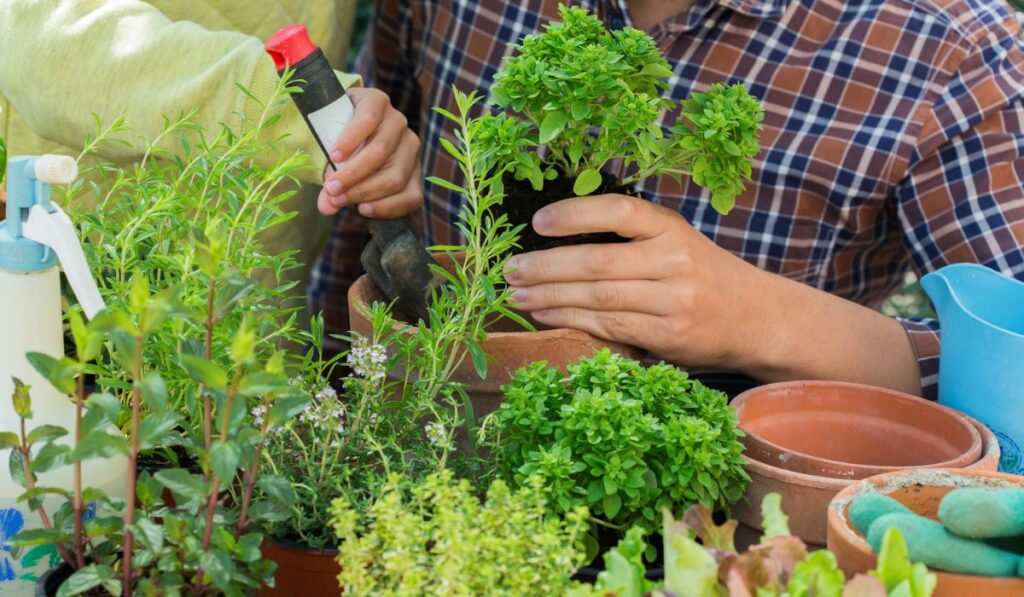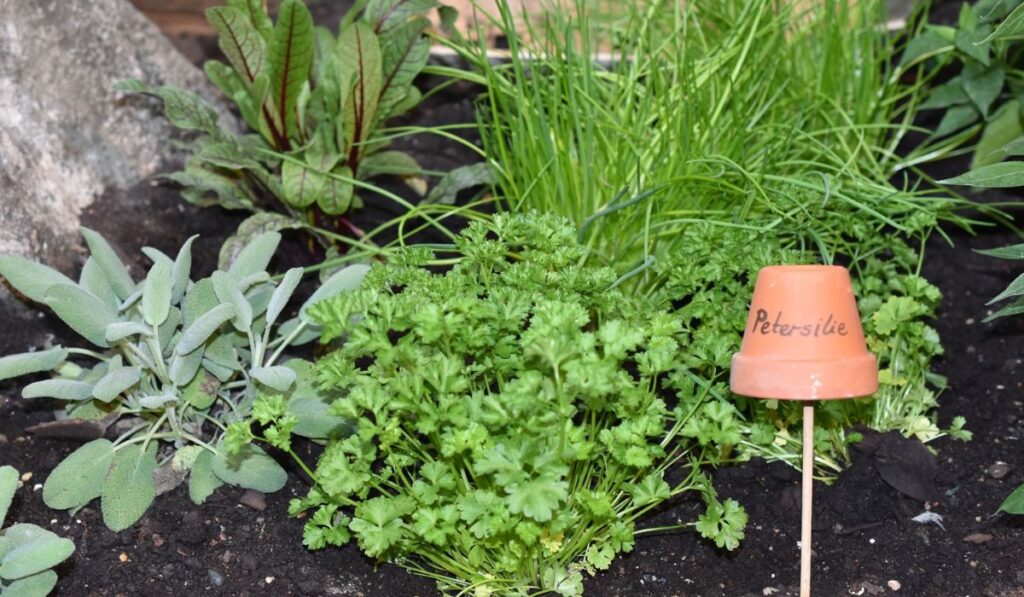Everyone likes to have fresh herbs on their food, sauces, or drinks, so having access to your own homegrown herb garden can make even the best-tasting dishes rise a notch. In addition, herbs are easy to grow and care for, and most aren’t susceptible to pests, making them the ideal plant to grow for beginners and seasoned gardeners alike.
Most herbs should be planted between March and August. Almost all herbs can be grown indoors on windowsills with proper sunlight and warm temperatures and outdoors in pots or directly into the garden. Regular watering, application of neem oil, and proper air circulation can prevent most pests.
Whether growing an annual, biennial, or perennial, herbs are easy to plant and care for. They can grow inside on windowsills to give year-long access to fresh herbs or outdoors for seasonal harvests. In either case, with regular watering and proper sunlight, anyone can enjoy the benefits of having freshly planted herbs in their garden.
When to Plant Herbs

Knowing when to plant herbs depends on the herb type, whether it’s an annual, biennial, or perennial. It also depends if you want to plant them indoors or outdoors, as well as your climate and particular weather conditions.
Annual and biennial herbs like basil, dill, coriander, and parsley can be started from seed between March and August. However, they are often short-lived and used in large quantities. Typically, they are picked while the plant is young to keep the flavor fresh and allow the plant to keep producing from spring until fall.
Perennial herbs such as rosemary, thyme, and sage can also be started from seed and are sown in spring. However, they do best sown in pots and then later transplanted in the ground to give them a good head start.
Herbs from the Mediterranean, such as rosemary, sage, lavender, and thyme, can also be started from cuttings. If taking a softwood cutting, do so in the spring, or if a semi-ripe cutting, then late summer to early fall. These can survive indoors over the winter on a windowsill and then later planted outside come spring once the risk of frost has passed.
Indoor vs. Outdoor Planting
Planting herbs outside depends on what you want to grow. Generally speaking, it is best to plant outdoors during the spring in a sunny spot with lots of fertile and free-draining soil.
Most herbs can be planted outdoors between March and August, but some can survive in January if supplied with cover and transplanted to a garden come spring.
The benefit of planting herbs inside is that they offer a constant supply of fresh herbs regardless of the weather and seasons. Some herbs like thyme, parsley, mint, chives, and French tarragon can continue to be harvested all year round as long as they are provided with enough sunlight on a south-facing windowsill.
How to Plant Indoors
It doesn’t matter what time of year to plant herbs indoors since they are not subjected to the same weather conditions as if they were outside.
- Start by sowing the seeds in trays (on Amazon) with moist peat-free seed compost and cover with a thin layer of compost and water.
- Next, place them in a propagator (on Amazon) or covered with a plastic bag. This will help germinate them faster so they can be transplanted to proper pots.
In winter, the decreased sunlight and temperature drops often slow the growth of herbs. Also, keep in mind that windowsills tend to be 10 to 15 degrees colder than the rest of the room, which could cause some plants to suffer.
How to Plant Herbs
Planting herbs is incredibly easy. They aren’t picky with the type of soil needed but make sure it can drain pretty well, or you run the risk of root rot. They need a good amount of sunlight, about 6 hours of direct sun, and can flourish in gardens and pots.
You also want to consider the herb you are growing, for herbs like mint are invasive and will quickly grow in any direction. It can easily take over an entire garden in one growing season.
If planting in containers, consider having the pots close together to create a more humid environment, but not too close so that there is poor air circulation. When using pots, you want to ensure a drainage hole at the bottom so excess water can flow out instead of stagnating.
Maintaining Herbs
Just like planting herbs, growing them is easy. However, you want to water your herbs when the top two inches of soil is dry, and try to water them from the base of the plant instead of overhead. This will minimize the amount of water on the leaves, which can help prevent mildew from growing.
Fertilize your herbs during their growing season, roughly every 2-4 weeks, with a low dose of water-soluble fertilizer (on Amazon). Be careful when fertilizing, as too much fertilizer or dosing them too often can produce subpar aroma and flavor.
When harvesting your herbs, you don’t want to take all the available leaves, or it could shock the plant. Make sure you don’t take more than ¾ of the plant, leaving several decent-sized leaves and branches to grow. Alternatively, cut back the entire plant and discard the roots and unusable stems if you want a single harvest.
Different Types of Herbs

- Basil: Great in Italian dishes and Thai curries, basil is a half-hardy annual that does well in warm and sunny environments like a windowsill. It requires a steady temperature of 59-77 degrees Fahrenheit or 15-25 degrees Celsius.
- Coriander: A fast-growing annual herb that does best when planted outdoors between April and July. Alternatively, it can be planted indoors in January and moved outdoors after the last frost.
- Dill: An annual herb that goes great on fish dishes. Dill does not like to be transplanted and is best planted outdoors between March and July.
- Mint: An incredibly versatile herb that will quickly take over any space it is given, so planting it in a pot is preferred. Mint is a perennial that can be planted from March to May in full sun to partial shade.
- Parsley: A hardy biennial herb that can be planted between April and July. It has a slow germination period of six weeks and shouldn’t be harvested until late spring and then again in late summer.
- Rosemary: A perennial herb that is drought tolerant and does not like waterlogged roots, so proper drainage is vital. Best grown in small pots between March and May. Germination tends to be sporadic and can occur anywhere from 1-2 weeks up to 3 months.
- Thyme: A perennial herb that does best in full sun and can tolerate dry soils. It should be sown from seed between February and April, beginning in trays, then transplanted outside once the last frost has passed.
- Chives: A cool-tolerant perennial herb that can be planted in early spring for an early summer harvest. Be careful when growing chives as it is an invasive plant when allowed to flower. Chives also make a great companion plant to deter pests.
- Oregano: A tender perennial that can be started in early spring and does well in containers or as ground cover along a path. Ensure full sun and well-draining soil when planting. Oregano also makes a great companion plant to deter pests.
Pests and Prevention
Most herbs are pretty hardy when it comes to pests, as many of them act as deterrents to bugs themselves. However, a few feed on the foliage, and most can be dealt with by simply providing the plant with proper care.
From regular watering to good air circulation and regular applications of diluted neem oil (on Amazon), most of your herbs will survive any pest that crops up.
- Aphids: Cause curling of the foliage and can be dealt with by using an insecticidal soap and regular applications of neem oil.
- Spider Mites: Seen by black dots under the leaves and webbing throughout the foliage. Spray the plant with a hose to dislodge the spider mites. While regular applications of neem oil can help prevent them.
- Parsley Worms: Black swallowtail caterpillars that morph into butterflies. It is best to leave these guys be and simply plant lots of parsley, dill, and fennel for them to feed on.
- Spittle Bugs: They leave spit-like froth on the foliage of herbs and can be washed off with water.
- Flea Beetle: They chew small holes into leaves, and the larvae can attack the plant’s root system. Controlling an outbreak before it gets terrible is ideal, providing a thick layer of mulch and frequent weeding.
- Rust: A disease that attacks mint plants pretty aggressively. It causes rusty orange lesions on the underside of the leaves and can be treated with a fungicidal treatment like azoxystrobin. Any rust-infested leaves should be burned or double-bagged and not put in compost or leaf bins, as it can spread like wildfire.
